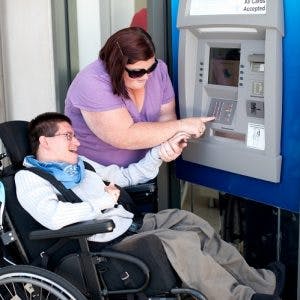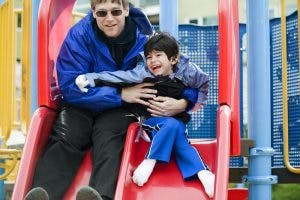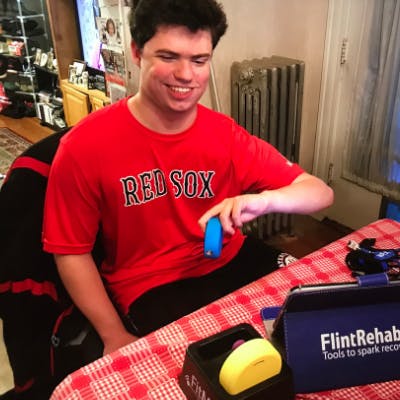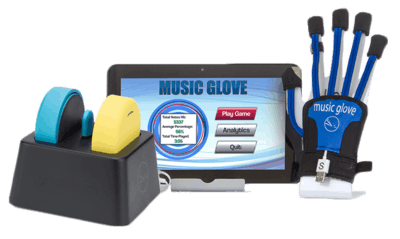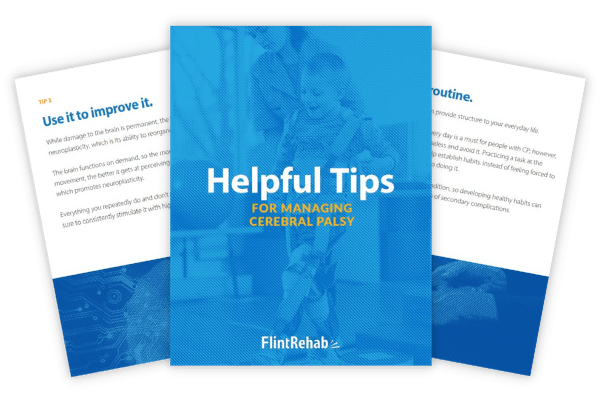Ataxic cerebral palsy is a type of cerebral palsy that is primarily characterized by poor balance and coordination. Only about 5% of all CP cases are ataxic, making it the rarest type.
Individuals with ataxic CP may experience difficulties coordinating their steps or performing tasks that require precision such as writing. Fortunately, there are ways to target these skills and improve them to optimize quality of life.
To help you understand what ataxic cerebral palsy is and how it affects the body, this article will discuss:
- What are the causes of ataxic cerebral palsy?
- What are the signs and symptoms of ataxic cerebral palsy?
- When should you see a doctor?
- How to treat ataxic CP
Causes of Ataxic Cerebral Palsy
Cerebral palsy is a developmental motor disability caused by damage to the brain before, during, or shortly after birth. Common causes of damage include premature birth, lack of oxygen in the brain, and infection.
Depending on which region of the brain is damaged, individuals will be diagnosed with different types of cerebral palsy. For example, ataxic cerebral palsy is caused by early damage to the cerebellum.
The cerebellum is the region of the brain primarily responsible for regulating balance and coordination skills, as well as fine-tuning your movements. Depending on the extent of damage to the cerebellum, the effects of ataxic cerebral palsy can range from mild to severe.
In the following section, we’ll discuss some of the most common signs of ataxic cerebral palsy.
Signs and Symptoms of Ataxic Cerebral Palsy

Ataxic cerebral palsy impairs balance and coordination; however, it can manifest itself differently in each individual depending on the severity of damage to the brain.
Generally, ataxic CP affects the entire body, including the muscles around the mouth and eyes. As a result, individuals may find it challenging to speak, chew, swallow, or control their eye movements.
Other common symptoms of ataxic cerebral palsy include:
- Wide-based gait. Many children with ataxic CP walk with their legs spread apart as it creates a more stable base. This helps compensate for the lack of balance skills.
- Speech difficulties. One of the most common speech irregularities in individuals with ataxic cerebral palsy is scanning speech (speaking in a monotone, sometimes breathy voice with unnecessary pauses in between syllables or unusual emphasis on certain syllables)
- Shaky movements. Individuals with ataxic CP often experience intention tremors, which describe increased trembling when purposefully reaching for something.
- Poor fine motor skills. Individuals with ataxic CP may struggle to perform tasks that require precision such as writing, typing or picking up objects.
- Frequent falling. Due to poor balance, children with ataxic CP are prone to falling (especially when walking on uneven surfaces).
- Abnormal eye movements. Ataxic cerebral palsy can also affect vision and eye movements, which can contribute to difficulties with balance and coordination.
- Hypotonia. Some people with ataxic CP will experience low muscle tone, which can be observed through flaccid, relaxed body parts. Lack of muscle tone makes it difficult to coordinate movements and maintain unsupported positions, generally resulting in greater energy expenditure.
- Trunk instability. Individuals with hypotonia may experience trunk instability and struggle to sit or stand for extended periods.
- Eating difficulties. Some people with ataxic CP can develop dysphagia, or difficulty swallowing, due to difficulties coordinating the muscles of the mouth.
Many of the effects of ataxic cerebral palsy can be improved through rehabilitative therapies, which we will discuss soon. Before we get there, let’s discuss when to seek medical attention.
When to Seek Medical Attention
Generally, ataxic cerebral palsy is easy to overlook in infants. A wide-based gait, falling, lack of fine motor skills, and speech difficulties are all typical during the early stages of child development. It isn’t until the child gets a little older that lack of balance and coordination become worrisome.
As a result, it’s essential for parents to keep an eye out for delayed motor development. One way to do this is to familiarize yourself with developmental milestones.
For example, by 18 months, your child should be able to walk independently. Delayed developmental milestones are often the first signs of cerebral palsy. The sooner signs and symptoms of ataxic CP are identified, the sooner management can begin, generally resulting in more optimal improvements.
Up next, we’ll discuss how individuals with ataxic cerebral palsy can develop their balance and coordination skills to improve their overall quality of life.
Ataxic Cerebral Palsy Treatment

Treatment for ataxic cerebral palsy focuses on targeting each individual’s specific symptoms to minimize the impact of motor impairments on one’s quality of life.
While damaged regions of the brain are not capable of regeneration, healthy parts of the brain can utilize neuroplasticity to improve functions affected by ataxic CP. Neuroplasticity is the central nervous system’s ability to make adaptive changes and reorganize its neural circuitry.
The brain is constantly adapting based on the actions we repetitively perform. Therefore, by consistently practicing the functions we wish to improve, functions affected by brain damage could potentially be rewired to healthy, undamaged regions of the brain and improved.
Treatment for ataxic cerebral palsy may include:
- Physical therapy focuses on developing your child’s balance skills and correcting abnormal walking patterns through targeted exercise. They may also address core strength and stability, and may recommend specific equipment, such as crutches or a walker, to improve walking abilities. Oftentimes, they can use games and activities, such as an obstacle course, to improve a child’s motivation to participate in therapy.
- Occupational therapy can help individuals develop their fine motor skills by practicing practical, everyday activities like grooming and eating. For children, occupational therapists may also focus on coordinating motions needed for play and addressing school-related skills. Occupational therapists may also educate individuals on how to use adaptive tools and compensatory strategies to make daily tasks easier to perform.
- Orthotic devices such as braces and splints provide structural support to help individuals with low muscle tone achieve better control and positioning.
- Speech therapy can help individuals with speech difficulties strengthen their oral motor muscles and become better communicators. If needed, individuals may also learn alternative communication strategies. Furthermore, speech therapists can address oral motor difficulties affecting eating and swallowing skills as appropriate.
Management interventions will vary depending on each individual’s specific motor impairments. Regardless of the types of treatment pursued, continuing to work on rehabilitative exercises and activities at home, rather than just during therapy sessions, can optimize neuroplasticity for greater improvements.
Understanding Ataxic Cerebral Palsy: Key Points
Individuals with ataxic cerebral palsy generally experience difficulties with balance and coordination due to cerebellum damage. As a result, they may walk with a wide-based gait, tremble when reaching for objects, fall over often, or even have speech or eating difficulties.
Although it cannot be reversed, ataxic CP can be managed through a combination of various therapies that focus on developing body awareness, strength, and fine motor skills. We hope this article helped you understand what ataxic cerebral palsy is and the best practices for managing its effects.







